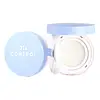What's inside
What's inside
 Key Ingredients
Key Ingredients

 Benefits
Benefits

 Concerns
Concerns

 Ingredients Side-by-side
Ingredients Side-by-side

Water
Skin ConditioningPropanediol
SolventDimethicone/Vinyl Dimethicone Crosspolymer
Skin ConditioningPearl Powder
Cellulose
AbsorbentSilica
AbrasivePhenoxyethanol
PreservativeButylene Glycol
HumectantXylitylglucoside
HumectantChlorphenesin
AntimicrobialHamamelis Virginiana Extract
AntiseborrhoeicAnhydroxylitol
HumectantPropylene Glycol
HumectantParfum
MaskingXylitol
HumectantDisodium EDTA
Alcohol
AntimicrobialPPG-26-Buteth-26
Skin ConditioningPEG-40 Hydrogenated Castor Oil
EmulsifyingIris Florentina Root Extract
MaskingZinc Sulfate
AntimicrobialRetinyl Palmitate
Skin ConditioningWater, Propanediol, Dimethicone/Vinyl Dimethicone Crosspolymer, Pearl Powder, Cellulose, Silica, Phenoxyethanol, Butylene Glycol, Xylitylglucoside, Chlorphenesin, Hamamelis Virginiana Extract, Anhydroxylitol, Propylene Glycol, Parfum, Xylitol, Disodium EDTA, Alcohol, PPG-26-Buteth-26, PEG-40 Hydrogenated Castor Oil, Iris Florentina Root Extract, Zinc Sulfate, Retinyl Palmitate
Water
Skin ConditioningDimethicone/Vinyl Dimethicone Crosspolymer
Skin ConditioningSilica
AbrasiveGlycerin
HumectantGlyceryl Glucoside
HumectantButylene Glycol
Humectant1,2-Hexanediol
Skin ConditioningC12-14 Pareth-12
EmulsifyingPhenoxyethanol
PreservativeXanthan Gum
EmulsifyingBenzoic Acid
MaskingMethylparaben
PreservativeChlorphenesin
AntimicrobialDisodium EDTA
Sodium Hyaluronate
HumectantGlucose
HumectantPolyglyceryl-3 Methylglucose Distearate
EmulsifyingCetearyl Alcohol
EmollientPropanediol
SolventHamamelis Virginiana Extract
AntiseborrhoeicAcmella Oleracea Extract
Skin ProtectingWater, Dimethicone/Vinyl Dimethicone Crosspolymer, Silica, Glycerin, Glyceryl Glucoside, Butylene Glycol, 1,2-Hexanediol, C12-14 Pareth-12, Phenoxyethanol, Xanthan Gum, Benzoic Acid, Methylparaben, Chlorphenesin, Disodium EDTA, Sodium Hyaluronate, Glucose, Polyglyceryl-3 Methylglucose Distearate, Cetearyl Alcohol, Propanediol, Hamamelis Virginiana Extract, Acmella Oleracea Extract
Ingredients Explained
These ingredients are found in both products.
Ingredients higher up in an ingredient list are typically present in a larger amount.
Butylene Glycol (or BG) is used within cosmetic products for a few different reasons:
Overall, Butylene Glycol is a safe and well-rounded ingredient that works well with other ingredients.
Though this ingredient works well with most skin types, some people with sensitive skin may experience a reaction such as allergic rashes, closed comedones, or itchiness.
Learn more about Butylene GlycolChlorphenesin is a synthetic preservative. It helps protect a product against bacteria in order to extend shelf life. In most cases, Chlorphenesin is paired with other preservatives such as phenoxyethanol and caprylyl glycol.
Chlorphenesin is a biocide. This means it is able to help fight the microorganisms on our skin. It is also able to fight odor-releasing bacteria.
Chlorphenesin is soluble in both water and glycerin.
Studies show Chlorphenesin is easily absorbed by our skin. You should speak with a skincare professional if you have concerns about using Chlorphenesin.
Learn more about ChlorphenesinThis ingredient is a silicone used to improve the texture of products and absorb oil. It does not get absorbed into the skin.
Like other silicones, Dimethicone/Vinyl Dimethicone Crosspolymer helps condition the skin by creating a barrier. In this sense, it can act as an emollient and trap moisture in.
This ingredient is a type of elastomer.
Learn more about Dimethicone/Vinyl Dimethicone CrosspolymerDisodium EDTA plays a role in making products more stable by aiding other preservatives.
It is a chelating agent, meaning it neutralizes metal ions that may be found in a product.
Disodium EDTA is a salt of edetic acid and is found to be safe in cosmetic ingredients.
Learn more about Disodium EDTAHamamelis Virginiana Extract comes from the witch hazel plant.
Unless it is specified to be non-alcohol, many types of witch hazel ingredients are distilled in denatured alcohol.
Witch Hazel has astringent, anti-inflammatory, antioxidant, and antibacterial properties.
The tannin content of witch hazel constrict the appearance of pores by drying out proteins. Witch hazel water gets anti-inflammatory and antibacterial properties from its catechin and gallic acid content.
However, witch hazel may be skin-sensitizing due to the tannin and fragrance compounds.
North American Indigenous groups have used witch hazel to help treat inflammation for centuries.
Learn more about Hamamelis Virginiana ExtractPhenoxyethanol is a preservative that has germicide, antimicrobial, and aromatic properties. Studies show that phenoxyethanol can prevent microbial growth. By itself, it has a scent that is similar to that of a rose.
It's often used in formulations along with Caprylyl Glycol to preserve the shelf life of products.
Propanediol is an all-star ingredient. It softens, hydrates, and smooths the skin.
It’s often used to:
Propanediol is not likely to cause sensitivity and considered safe to use. It is derived from corn or petroleum with a clear color and no scent.
Learn more about PropanediolSilica, also known as silicon dioxide, is a naturally occurring mineral. It is used as a fine, spherical, and porous powder in cosmetics.
Though it has exfoliant properties, the function of silica varies depending on the product.
The unique structure of silica enhances the spreadability and adds smoothness, making it a great texture enhancer.
It is also used as an active carrier, emulsifier, and mattifier due to its ability to absorb excess oil.
In some products, tiny microneedles called spicules are made from silica or hydrolyzed sponge. When you rub them in, they lightly polish away dead skin layers and enhance the penetration of active ingredients.
Learn more about SilicaWater. It's the most common cosmetic ingredient of all. You'll usually see it at the top of ingredient lists, meaning that it makes up the largest part of the product.
So why is it so popular? Water most often acts as a solvent - this means that it helps dissolve other ingredients into the formulation.
You'll also recognize water as that liquid we all need to stay alive. If you see this, drink a glass of water. Stay hydrated!
Learn more about Water